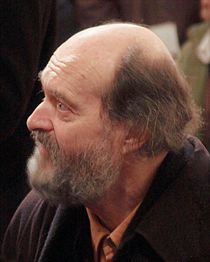 My experience singing in choirs, my love for jazz and 20th century harmony, always led me to love some of the more, shall we say, difficult 20th and 21st century choral composers. Arvo Pärt is certainly one of them. Every composer gets criticism, especially those who are recognized before they are dead. I don't really care much about such controversy, I just love his sacred choral works.
My experience singing in choirs, my love for jazz and 20th century harmony, always led me to love some of the more, shall we say, difficult 20th and 21st century choral composers. Arvo Pärt is certainly one of them. Every composer gets criticism, especially those who are recognized before they are dead. I don't really care much about such controversy, I just love his sacred choral works.It is not often that something described as minimalism gets across such intense passion. And it is not often that such intense passion actually enables genuine meditation. So I just have to do a little bit of praising this man's work. Pärt is an Estonian composer living in Germany. Do a google search for more, but the Wikipedia article on him is helpful.
Right now I am listening to his setting of St. John Chrysostom's Litany for the hours for monks. First of all, you simply have the awe-inspiring words of the saint himself "even if I had not done anything good before Thee, do Thou help me, in Thy grace, to make a good beginning." It reminds me of St. Benedict's Rule, "always we begin again." Moreover, "O Lord, implant in me the root of all good - Thy fear in my heart." Finally, I am just struck by:
O Lord, shelter me from certain men,
from demons and passions,
and from any other unbecoming thing.
I love the possible play on words with the adjective "certain" modifying "men." I love the patristic angelology here clearly and analogically (organically?) linking the fallen angels to the vices (passions outside of rational control). I love the simultaneous domestication of the demonic and the archetypal amplification of simple, human bad habits.
But then it is not just the words, of course, but the kind of powerful pulsating choral phrasing that Pärt devises for setting them. He rolls eastern, Byzantine and Russian-style chant with 20th century harmony through the focusing lens of his minimalist "tintinnabulation." I couldn't find a public mp3 of the above piece, but the following should give an idea of the general technique, and will, hopefully, convey some of its power:
Check out this website, Arvo Pärt Website, dedicated to Pärt and the free mp3 samples available there.
So, "tintinnabulation" is this great word that Pärt invented to describe a technique he stumbled upon to generate, in a minimalist fashion, these kinds of simple chant-like patterns that achieve meditative (in their simplicity) emotional depth (in their harmonic complexity). Here is how the Wikipedia article about it describes it: "tintinnabular music is characterized by two types of voices, the first of which (dubbed the "tintinnabular voice") arpeggiates the tonic triad, and the second of which moves diatonically in stepwise motion."
I practiced this the other day with my wife. I sang the arpeggiation of the tonic triad in solfège and she simply went up and down the scale in solfège. The result was suddenly "Pärt"!
There is so much to say and medidate on with regards to Pärt and tintinnabulation, but I'd like to end this accolade by relating it back to another major focus of my web log: the monome. I am not a programmer (yet), but a dabbler. I simply appreciate and make use, in my minimal way, of the great wealth of monome applications shared among the monome community out there. But it seems to me that this technique of tintinnabulation is just perfect for mapping to the "decoupled grid" that is the monome! (Sacred) minimalist technique meets (technological) minimalist interface! I've even got a name for it: "tintinnabulome," of course. It seems that something like Stretta's Polygomé, blended with his Cygnet could pull this off: set up the tintinnabular chord voicing with one"hold," then, with another "hold," or, perhaps in another "frame" set up the undulating scale. Of course, different modes and chordal possibilities could be offered, like tritones and the like.
I am serious: is there anyone out there in the monome community who can program and would like to take this on? Creative commons attribution on the name, "tintinnabulome," and then share it with all! Anyone? Stretta? And, Stretta, if you are interested, don't forget that I only have a 64! Thanks for reading and thanks for the support.


